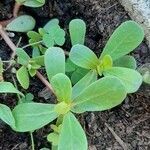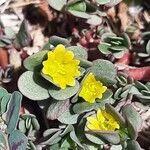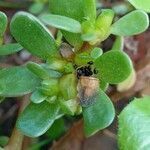Annual herb, succulent; fibrous-rooted; stems prostrate or decumbent, spreading to 30(-50) cm long, purplish, glabrous or with few nodal hairs of ca. 1 mm long. Leaves alternate, upper leaves often opposite; stipules inconspicuous, minutely fimbriate or absent; petiole 1-8 mm long; blade fleshy, flat, elliptical, obovate or spathulate, 0.6-4 x 0.2-2 cm, obtuse or truncate at apex, cuneate at base, glabrous. Inflorescence of terminal, solitary or clustered, sessile or subsessile flowers, clusters of up to 10 flowers. Sepals green, broadly ovate to orbicular-ovate or triangular, 2.8-5 x 2.8-4 mm, broadly keeled above, united at base, usually persistent; petals yellow, 4-5, obovate, 3-8 x 1.5-3 mm, ephemeral; stamens 6-20, filaments 1.5-1.75 mm long, anthers broadly oblongoid or globose, 0.4-0.5 mm long; ovary half-inferior, ovoid or short-conical, stigmatic branches 4-6. Fruit broadly ovoid to fusiform, ca. 4-5 x ca. 2.5 mm, circumscissile from ca. 1/3 up from base, to near middle; seeds black, cochleate, ca. 0.5-0.8 mm wide, very finely and minutely granulate or tuberculate.
Plants herbaceous, radially spreading and prostrate or somewhat ascending, glabrous throughout, the roots fibrous. Leaves alternate, elliptic to obovoid, 1-3 cm. long, 0.5-1.0 cm. broad, generally obtuse at the apex, cuneate at the base, plane; petiole 1-8 mm. long, the stipules fimbriate, inconspicuous. Inflorescence with the flowers crowded, the flowers sessile or essentially so, yellow. Perianth tube crateriform, 1 mm. long, 1.5 mm. in diameter; sepals ovate, 3.0-4.5 mm. long, 3-4 mm.-broad, strongly keeled, connate at the base, generally persistent and enclosing the operculum of the fruit; petals 4, 3.0-4.5 mm. long, 1.5-3.0 mm. broad; stamens 6-15, the filaments 1.5-1.75 mm. long, the anthers globose, to 0.5 mm. long and broad; ovary half-inferior, short-conical, the style lobes 4-6. Capsule ovoid to fusiform, 6-9 mm. long, about 2.5 mm. in diameter, circumscissile slightly below the middle; seeds almost cochleate, about 0.5-0.75 mm. in diameter, the testa minutely tuberculate, almost black.
Herbs annual. Stems sometimes flushed red or purple, not articulated, prostrate or decumbent, less often ± erect, diffuse, much branched; leaf axils with a few inconspicuous stiff bristles. Leaves alternate or occasionally subopposite; petiole short; leaf blade flat, obovate, 10-30 × 5-15 mm, base cuneate, apex obtuse, rounded, truncate, or retuse. Flowers in clusters of 3-5, 0.4-0.5 cm in diam., surrounded by involucre of 2-6 bracts. Sepals green, helmeted, ca. 4 mm, apex acute, keeled. Petals 5, yellow, obovate, 3-5 mm, slightly connate at base, apex retuse. Stamens 7-12, ca. 12 mm; anthers yellow. Ovary glabrous. Stigma 4-6-lobed. Capsule ovoid, ca. 5 mm. Seeds glossy black when mature, never iridescent, obliquely globose-reniform, 0.6-1.2 mm; testa cells stellate, usually with central peglike tubercle, sometimes without and then surface ± granular. Fl. May-Aug, fr. Jun-Sep.
Glabrous taprooted annual herb. Stems reddish, prostrate to ascending, (5)-10-30-(45) cm long. Lvs alternate to subopposite, fleshy, shiny, often red-tinged, obovate to oblong, cuneately narrowed to a short petiole, obtuse to almost retuse, (5)-10-15-(30) × (2)-3-8-(10) mm; axillary hair-tufts short. Fls < 1 cm diam., (1)-3-(7) in sessile terminal clusters soon overtopped by subapical branches, subtended by membranous, ovate-acuminate, pinkish bracts. Sepals green, hooded, overlapping, fleshy, falling at fruiting, 5 mm long. Petals yellow, soon falling. Stamens 6-15; anthers yellow. Style branches 3-6. Capsule 3-7 mm long, ovoid, circumscissile. Seeds many, ovoid, shining, dark red-black, finely tuberculate, 1 mm long.
Herb, up to c. 40 cm. Leaves spirally arranged to subopposite, obovate to spathulate, up to 40 by 20 mm, with inconspicuous, up to c. 1 mm long axillary hairs. Capituli 2-30-flowered. Mostly 1-2(-3) of the 2-8 involucral leaves with an axillary axis. Flowers surrounded by up to c. 5 by 6 mm long bracteoles and inconspicuous hairs. Sepals up to c. 6 by 6 mm, carina up to c. 3 by 2 mm. Petals (4-)5, broadly obovate, up to 7 by 6 mm, yellow. Stamens 7-10(-15); filaments up to 4 mm; anthers 0.2-0.5 by 0.2-0.4 mm. Style up to c. 5 mm with (4-)5 arms. Fruit ovate, c. 4 by 3 mm; operculum ⅓-½, as high as the fruit, shining, straw-yellow. Seeds ∞, ½-1. 0, granulate; testa cells stellulate, with many fine tubercles.
Plants annual, glabrous; taproot 2-10 cm. Stems prostrate, succulent; trichomes at nodes and in inflorescence absent or inconspicuous; branches to 56 cm. Leaf blades obovate or spatulate, flattened, 4-28 × 2-13 mm, apex round to retuse or nearly truncate; involucrelike leaves 1-4. Flowers 3-10 mm diam.; petals yellow, oblong, 3-4.6 × 1.8-3 mm; stamens 6-12(-20); stigmas 3-6. Capsules ovoid, 4-9 mm diam. Seeds black or dark brown, orbiculate or elongate, flattened, 0.6-1.1 mm; surface cells ± smooth, granular, or stellate, with rounded tubercles. 2n = 18, 36, 54.
Stem prostrate, usually purplish-red, glabrous, repeatedly branched, forming large mats, edible when young; lvs edible, succulent but flat, spatulate to obovate-cuneate, 1–3 cm, commonly rounded at the summit, the cauline alternate or occasionally opposite; fls solitary or in small terminal glomerules, sessile, self-compatible, yellow, 5–10 mm wide; sep ± acute; stamens mostly 6–10; style-branches 4–6; seeds with low, blunt tubercles, requiring light for germination; polyploid series on x=9. A cosmopolitan weed, probably originally native to s. Asia. All summer.
Annual, glabrous, ± fleshy herb, branches prostrate, up to 0.30 m long. Leaves ± crowded towards ends of branches, obovate-spathulate, up to 30 x 12 mm, apex rounded, venation reticulate, petiolate; stipular hairs few, ± 1 mm long, caducous. Flowers terminal, up to 5, surrounded by subverticillate leaves. Sepals with tube ± 2 mm long. Petals 4, yellow, ± 8 mm long, obovate-oblong. Flowering time Jan.? Fruit an obovoid capsule, enveloped in corolla remains. Seeds many, ± 0.5 mm in diam., black, reniform, verrucose-granulate.
A spreading branched herb. It lies flat on the ground. It grows each year from seed. The plants spread 10 to 50 cm wide. The stems are purplish. The leaves are fleshy, flat and shaped like a wedge at the base. They are 1.5 to 2.5 cm long and 0.3-1 cm wide. The flowers are yellow and occur in a few rounded heads. They are 0.8-1.5 cm across. They bloom about the middle of the day. The capsules are 0.5 cm long and oval. The seeds are black and shiny.
Leaves alternate and often somewhat crowded towards the ends of the branches, sessile or shortly stalked, up to 3·0 × 1·2 cm., obovate-spathulate, apex rounded or truncate; stipular hairs very few, inconspicuous, caducous, c. 1 mm. long.
Annual herb, up to 0.05 m high. Stems procumbent, reddish. Leaves with shiny; blade obovate, up to 20 x 10 mm, stipular hairs very few, inconspicuous and caducous, ± 1 mm long. Flowers: corolla yellow; Nov.-Feb.
Glabrous, rather fleshy annual herb with spreading or prostrate branches. Leaves obovate-spathulate. Stipular hairs very few, inconspicuous and caducous, 1 mm long. Flowers yellow.
Flowers terminal, solitary or up to 5, surrounded by a cluster of subverticillate leaves; bracts membranous, c. 3 mm. long, ovate-acuminate.
Sepals 2–4 mm. long, united below into a tube c. 2 mm. long, free portions fleshy, oblong-ovate, keeled or slightly winged.
Annual glabrous rather fleshy herb with numerous spreading or prostrate branches up to 30 cm. long and up to 5 mm. in diam.
Capsule obovoid to ovoid, enveloped in the marcescent corolla, transversely dehiscent across the middle.
Petals yellow, 4–8 mm. long, united at the base, obovate-oblong to obovate, sometimes emarginate.
Seeds many, c. 0·5 mm. in diam., dull black, reniform, bluntly verrucose-granulate.
Common annual ruderal, with spreading or prostrate succulent branches
Ovary ovoid; style short, with 3–6 subulate lobes.
Flowers bright yellow.
Stamens 7–12.













